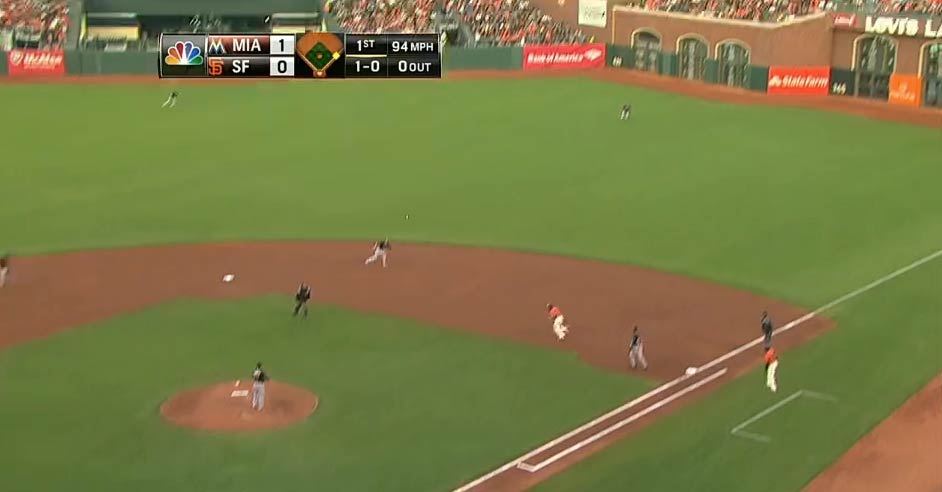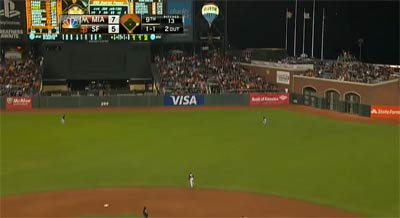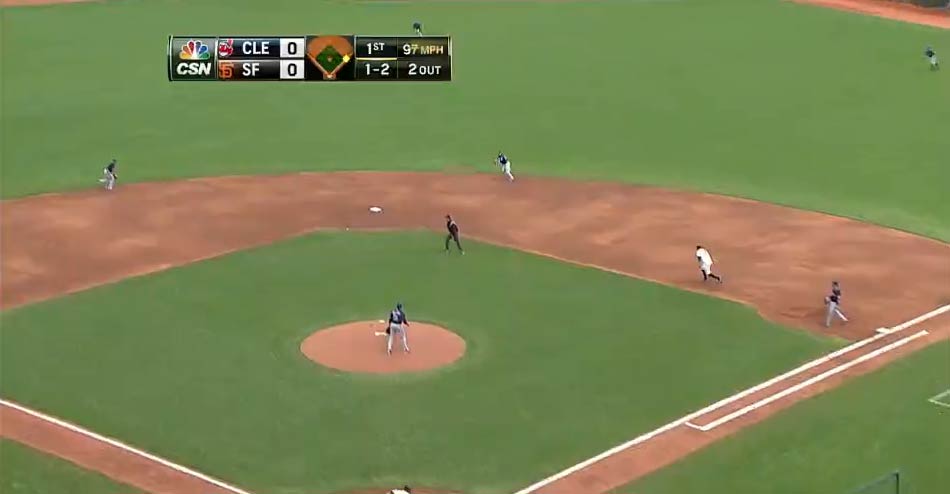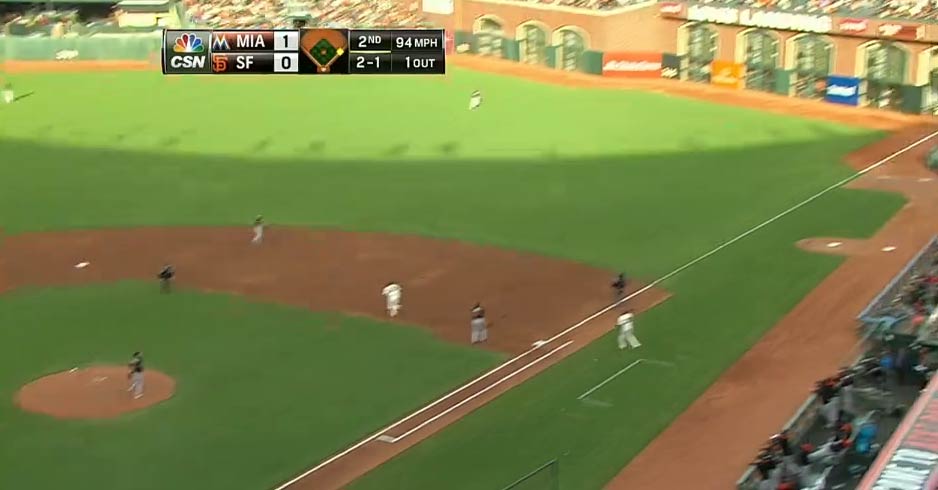Buster Posey represented the tying run when he batted in the ninth inning against Miami on Friday night. He got a 1-1 slider in the middle of the plate and drove it into deep right-center, toward triples alley. As soon as the crowd could raise its voice, though, it went quiet: Giancarlo Stanton was standing right there.
Whether that ball was hit hard enough and deep enough for Posey to get extra bases under normal circumstances is debatable, but from the right-field seats (where I was) it was jarring to see the contact, the flight off the bat, and, immediately, a stationary defender standing still and waiting for it. That's not where right fielders stand. So how did Stanton get there?
Here's where the Marlins' right fielder played various Giants hitters this weekend; below each is a screengrab of the same batter hitting in a Giants game this year against a different opponent (first one found among a variety of series).


Pablo Sandoval (batting left-handed):

 Hunter Pence:
Hunter Pence: 
 Buster Posey:
Buster Posey:


Also, where the Marlins played Brandon Crawford,

 and Gregor Blanco:
and Gregor Blanco:

In some cases, the difference is a step or two. In some, it's, what, 15 feet? 25? It's clear that, with so much land to cover in right-center, and relatively little land to cover in straight-away right, the Marlins have concluded that the outfielders should pull way over to cut off the triple.
The Marlins didn't shift this extremely against the Giants last year. Skimming highlights from their June series (like this one featuring Hunter Pence, this one with Joaquin Arias, this one for Gregor Blanco, this other one with Pence, and this one with Buster Posey), the right fielder played somewhere between straight-up and shaded well over, but never shifted to the extent that he has this year.
(It's not just against the Giants that the Marlins have done this. Juan C. Rodriguez, who covers the Marlins for the Sun Sentinel, tells me that Stanton "definitely has been shading to center. I can remember making a mental note a few times of how far he's had to run for anything down the right-field line." It's pretty visible when he's shading some batters—consider where he's playing Adrian Gonzalez, and where the Giants did—but not as routine or as noticeable as it was against the Giants, and in many cases—for instance, Jason Heyward—he's playing no differently than other teams do.)
Playing out of position in the infield is one thing, exposing the defense to unexpected single. But the outfield can be more dangerous, as the routine becomes not just a single but, possibly, a double or a triple. The Marlins benefited from the alignment in this series. They also paid for it. They also almost paid for it. A series of plays that the positioning factored into:
The right fielder catches it way out of position, though in a normal alignment it would likely have been caught by the center fielder. (The right fielder actually dropped it on the transfer, incidentally, but replay upheld the catch.)
Again, the right fielder (Ed Lucas) is way out of position, almost comically out of position as he drifts at the end. This ball was in the air so long that I imagine a center fielder playing in normal position would have caught it.
The pitcher's hop after contact gives it away: This ball was crushed into triples alley, but the right fielder barely had to move. Off the bat, I'd have confidently said extra bases. But Inside Edge, assessing the play based on the right fielder's starting position, ruled it to be routine. And it was. All of these catches, including the game-ending catch by Stanton that we started this piece with, were judged routine by Inside Edge, and they were. We'd feel different about a couple of them, at least, if the outfielders were playing straight up.
As for the plays where the defender might have been hurt by his positioning:
This line drive is obviously uncatchable in any alignment, but with two outs and the slow Mike Morse running from second, it's easy to imagine that he might have been held against Giancarlo Stanton's arm if Stanton were charging straight in on a one-hop line drive. Instead, though, Stanton doesn't get to field it as quickly or with the momentum toward the plate. It's easy for Morse to score.
This gives you a pretty good sense of how far off the line Stanton is; he barely looks like he's moving as he begins the three-week journey into the right-field corner. It's an easy triple. Might have been regardless, but it's certainly plausible (probable) that a normal alignment keeps Pence to a double.
Finally, the play that almost burned the Marlins, in the eighth inning of a tied game Friday. Morse led off with this fly ball:
Stanton made a fantastic catch—Inside Edge says it's at the furthest end of their "60-90 percent catchable" category—on what would otherwise be a fairly routine play, complicated only by the presence of the wall. Had Stanton missed it, then the alignment would have likely sent the Marlins into the ninth inning trailing. That's part of what makes it hard to consider radical outfield defense as easily as we have accepted radical infield defense: the stakes are so much higher when we're talking about leadoff triples instead of leadoff singles. Of course, we're also talking about taking away triples.
We haven't considered what this alignment does for the center fielder, and the left fielder. Each has more freedom to move a bit away from right field, sealing off the left-center gap or covering the left-field line. I didn't include any plays here where that was a factor against the Giants—I didn't notice any—but it would be another benefit.
As we sat up in our second-deck seats that night, we wondered whether we were crazy, or whether our perception was skewed, and the Marlins were playing right field just as any other team plays any other right field. Alex Pavlovic, writing in the San Jose Mercury News, reassured me in his post-series wrap-up:
We’ve seen a lot of teams—including the Giants—have success with shifts this season, but I can’t remember seeing another team be this aggressive with the Triples Alley shift. The Marlins pretty much planted their right fielders, first Giancarlo Stanton and then Ed Lucas, in the alley and shifted the center fielder and left fielder over toward downtown San Francisco a couple dozen feet. For the most part, it was successful, and it robbed Crawford of a triple. Might be something the Giants copy at some point.
And that last part is maybe the most interesting part of this. This is the Giants' 15th season in AT&T Park. They're as familiar with the dangers of triples alley as anybody; they're also aware of the cushion triples alley provides to pitchers who can pitch "to" that part of the park. If anybody was going to shift 25 extra feet off the line, you'd think it would have been them. Maybe that means that the Marlins' alignment is misguided; if the Giants don't do it, maybe it's because it's a lousy idea. On the other hand, the radical idea that we've grown accustomed to this year—the infield shift—was right there in plain sight for a hundred years before anybody thought to truly exploit it.
Thank you for reading
This is a free article. If you enjoyed it, consider subscribing to Baseball Prospectus. Subscriptions support ongoing public baseball research and analysis in an increasingly proprietary environment.
Subscribe now

Fun. Glad these innovations continue.